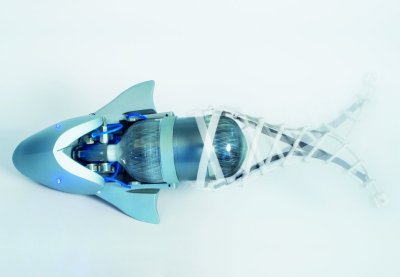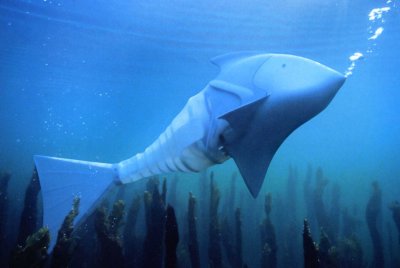Compressed Air Fish
 (Click on images to enlarge. Note the top image has a compressed air canister inside its body.)
(Click on images to enlarge. Note the top image has a compressed air canister inside its body.)
This is wild, A mechanical fish, which can be automated as a robot, or remotely controlled, is powered by compressed air. Otherwise known as a pneumatic fish, or as the Festo company refers to it, the "Airacuda"(created by Festo).
I can imagine someone coming up with a submarine version big enough to fit humans on board, and it could come up to surface and recharge it's compressed air tanks using wind energy or photovoltaic solar energy collected from the sun. The wind energy could be either through mechanical means, coupled mechanically, directly to the compressors, or by conversion to electricity, and then using the electricity to to power air compressors.
It might also be able to recharge its compressed air and electric components, by anchoring itself to the sea floor with an anchor, and using the the powerful under sea currents to spin a turbine, which could recharge its electricity.
It may be able to do a similar thing by going up to the surface of the ocean and spreading a wind sail to pull it across the water, with the resistance of water turbines electric motors collecting the energy through their resistance.
Here is what the news report of this fishPneumatic fish is 'more efficient than a propeller'
One of the most striking sights at this year's Hannover Fair was a pair of remotely controlled mechanical "fishes" swimming in an uncannily fish-like way around a large tank of water on Festo's stand. Beneath the fishes' silicone skin, a combination of pneumatics and electronics was used to simulate the way a real fish propels itself.
The project to develop the "Airacuda" fishes was initiated by Festo's chairman, Dr Wilfried Stoll. After considerable testing and research, the development team came up with a propulsion system based on Festo's "fluidic muscles" - essentially, flexible rubber tubes which shorten when filled with pressurised air.
The fish's rear fin is moved to and fro in an S-shaped motion by two fluidic muscles, with two more providing the steering. The fin contains a flank which alternates between tension and compression, and is connected to a rib structure. When one flank is pressurised, the structure arches in the opposite direction to the force.
The fluidic muscles shorten diagonals in the structure in an alternating fashion to produce a propulsion effect which, Festo says, is more efficient than a propeller, converting a greater proportion of effort into thrust.
To rise and sink, the Airacuda uses an air bladder - a cavity that can be filled with water or air. A pressure sensor determines the depth and sends a signal to a controller which regulates valves to apply either compressed air or a vacuum to the cavity.
The air to drive the Airacuda is held at 300 bar in a 1.5 litre cylinder in the fish's head. It is distributed to the 5mm-diameter fluidic muscles via electronically controlled valves. A tank containing 400 litres of air can propel the fish for about 35 minutes.
To add extra "life" to the 100cm-long fish, a stream of bubbles emerges from its mouth and its eyes glow blue.




No comments:
Post a Comment